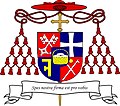Basket (heraldry)
The basket is a common figure in heraldry and is rarely shown in the shield , but more often in the coat of arms . It replaces the crown over the helmet , rests on the helmet cover and is used here to hold flowers or tufts of feathers, such as peacock feathers . It is also used to depict growing animals or people.
The basket can be with or without a handle. The tinging is done according to the heraldic rules. Unimaginatively, he is tinged with brown. The basket can be empty or full, which must be mentioned in the description .
In the description of the coat of arms the nest of the pelican with a basket is wrongly described. The basket also stands for the beehive (beehive) if, in addition to the bee as a heraldic animal, it is included in the coat of arms. In the shield, for example, it is in the coat of arms of Cardinal Meisner .
The basket is also an attribute of saints and so Bacchus is marked with it. St. Elisabeth and St. Dorothea with flowers or fruits in the basket should be recognizable by this.
The municipality of Korb has a golden beehive as a talking coat of arms .
In French heraldry at the time of the Napoleonic era, a basket was used as a "classification symbol" for third-order cities. In the shield there was a red crossing on the left with a silver "N" raised by a five-pointed star . Above the shield was a golden basket filled with golden ears of wheat, on which hung a green wreath of olive branches on the right and oak branches on the left with red flying ribbons.
Minnigerode (noble family) , basket in the upper coat of arms
Basket as a talking coat of arms
Sand am Main a basket as a sign of basket making craftsmanship
golden salt baskets in the coat of arms of the Salzlandkreis
Individual evidence
- ^ Oscar Mothes (ed.): Illustrirtes Bau-Lexikon. Volume 2: F-M. 2nd, completely revised and enlarged edition. Verlagbuchhandlung Otto Spamer, Leipzig et al. 1866, p. 406 .





